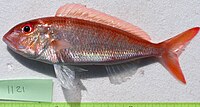Calydiscoides
| Calydiscoides | |
|---|---|

| |
| Calydiscoides euzeti | |
| Scientific classification | |
| Kingdom: | |
| Phylum: | |
| Class: | |
| Subclass: | |
| Family: | |
| Genus: | Calydiscoides Young, 1969
|
| Species | |
|
Many, see text | |
Calydiscoides is a genus of monopisthocotylean monogeneans, included in the family Diplectanidae.[1]
The genus currently includes 16 species, which are all parasitic on the gills of marine fish of the family Lethrinidae and Nemipteridae.[1][2] All species are from the Indo-Pacific Ocean. The type-species of the genus is Calydiscoides australis Young, 1969.[3]
Morphology

All species of Calydiscoides are small animals, ranging 0.5–1 mm in length.
As with most monogeneans, they are flat, with an anterior head bearing four oculi and head glands, a main elongate body and a posterior haptor. The digestive system includes an anterior muscular pharynx, and two lateral intestinal branches (or caeca); as in all Platyhelminthes, there is no anus. The haptor, in the posterior part of the body, is a specialized organ used to attach to the host. The haptor includes sclerotized elements, namely a ventral bar, two lateral (dorsal) bars, two ventral hooks, and two dorsal hooks, and fourteen hooklets. As in most diplectanids, the haptor bears characteristic, structures called squamodiscs (one ventral and one dorsal).
The squamodiscs of species of Calydiscoides are special: they are lamellodiscs, which are made up of concentric lamellae, not separate rodlets as in regular squamodiscs. The diameter of the lamellodiscs range 25–60 µm. When observed from its concentric axis (ventral or dorsal observation of the specimen, ‘polar’ view of the lamellodisc), the lamellodisc appears as concentric circles.[2] Generally, central lamellae are circles, but peripheral lamellae may be circles or semicircles.
Adults are hermaphroditic. The reproductive organ include a single ovary and a single testis. As in all diplectanids, the ovary (or germarium) is anterior to the testis and loops around the right intestinal caecum. Species of Calydiscoides are characterized by a sclerotized male copulatory organ, which is used in systematics to differentiate species.
Systematics
The characteristics of the lamellodisc, without paired elements, is the main character which differentiate Calydiscoides from other genera of the family Diplectanidae. Relationships of Calydiscoides Young, 1969 with Protolamellodiscus Oliver, 1969 are not clear; the two genera were described almost simultaneously, and it might be that they are synonym.[2][4]
Hosts
Hosts of species of Calydiscoides are only members of the families Nemipteridae (Threadfin breams) and Lethrinidae (Emperors). These families are restricted to the Indo-Pacific Ocean. Lethrinids known to harbour Calydiscoides species include Lethrinus miniatus, Lethrinus nebulosus and Lethrinus atkinsoni;[2] nemipterids include Nemipterus japonicus, Scolopsis temporalis, Scolopsis monogramma, Scolopsis margaritifera and Pentapodus aureofasciatus.[5][6] In all cases, species of Calydiscoides were only found on the gills of the fish.
List of species
List according to the World Register of Marine Species[7]
|
|
References
- ^ a b Oliver, G. (1987). Les Diplectanidae Bychowsky, 1957 (Monogenea, Monopisthocotylea, Dactylogyridea). Systématique. Biologie. Ontogénie. Écologie. Essai de phylogenèse. Thèse d'État, Académie de Montpellier, Université des Sciences et Techniques du Languedoc, France. doi:10.6084/m9.figshare.1295274

- ^ a b c d e Justine, Jean-Lou (2007). "Species of Calydiscoides Young, 1969 (Monogenea: Diplectanidae) from lethrinid fishes, with the redescription of all of the type-specimens and the description of C. euzeti n. sp. from Lethrinus rubrioperculatus and L. xanthochilus off New Caledonia". Systematic Parasitology. 67 (3): 187–209. doi:10.1007/s11230-006-9087-x. ISSN 0165-5752. PMID 17417716.
- ^ a b c d e Young, P. C. (1969). "Some Monogenoideans of the Family Diplectanidae Bychowsky, 1957 from Australian Teleost Fishes". Journal of Helminthology. 43 (1–2): 223–254. doi:10.1017/S0022149X00004053. ISSN 0022-149X. PMID 5381127.
- ^ Kritsky, D. C.; Jimenez-Ruiz, F. A.; Sey, O. (2000). "Diplectanids (Monogenoidea : Dactylogyridea) from the gills of marine fishes of the Persian Gulf off Kuwait" (PDF). Comparative Parasitology. 67: 145–164.

- ^ a b c d e Lim, L.H.S. (2003). "Species of Calydiscoides Young, 1969 (Monogenea: Diplectanidae Bychowsky, 1957: Lamellodiscinae Oliver, 1969) from nemipterid fishes off Peninsular Malaysia". Systematic Parasitology. 55 (2): 115–126. doi:10.1023/A:1024098701036. ISSN 0165-5752.
- ^ a b Justine, Jean-Lou; Brena, Pierpaolo (2009). "Calydiscoides limae sp. nov. (Monogenea, Diplectanidae) from Pentapodus aureofasciatus (Perciformes, Nemipteridae) off New Caledonia". Acta Parasitologica. 54 (1). doi:10.2478/s11686-009-0009-3. ISSN 1896-1851.
- ^ WoRMS: Calydiscoides Young, 1969
- ^ Ding, X. & Zhang, J. 1996: Monogenoidea of Chinese marine fishes. VII. A new species of the genus Calydiscoides Young, 1969 (Dactylogyridea: Diplectanidae) [in Chinese, with English summary]. Annual Bulletin of the Society of Parasitology, Guangdong Province, Guangzhou, 18, 57-59.
- ^ a b c Yamaguti, S. 1953: Parasitic worms mainly from Celebes. Part 2. Monogenetic trematodes of fishes. Acta Medicinae Okayama, 8, 203-256 + 209 Pl. Article Archived 2015-02-09 at the Wayback Machine PDF Archived 2015-02-09 at the Wayback Machine

- ^ a b Oliver, Guy (1984). "Quelques espèces du genre Calydiscoides Young (Monogenea, Monopisthocotylea, Diplectanidae), parasites de Perciformes du Récif de la Grande Barrière (Australie)". Zoologica Scripta. 13 (3): 189–193. doi:10.1111/j.1463-6409.1984.tb00035.x. ISSN 0300-3256.
- ^ Pillai, V. S.; Pillai, N. K. (1976). "Monogenean parasites of the marine fishes of the Kerala coast. I". Aquatic Biology. 1: 85–100.
- ^ a b Thoney, DA (1989). "Morphology of Calydiscoides nemipteris, sp. nov. (Monogenea), with a redescription and revision of the genus". Australian Journal of Zoology. 37 (1): 37. doi:10.1071/ZO9890037. ISSN 0004-959X.
- ^ Rascalou, Guilhem; Justine, Jean-Lou (2007). "Three species of Calydiscoides (Monogenea: Diplectanidae) from five Lethrinus spp. (Lethrinidae: Perciformes) off New Caledonia, with a description of Calydiscoides terpsichore sp. n." (PDF). Folia Parasitologica. 54 (3): 191–202. doi:10.14411/fp.2007.026. ISSN 0015-5683.



